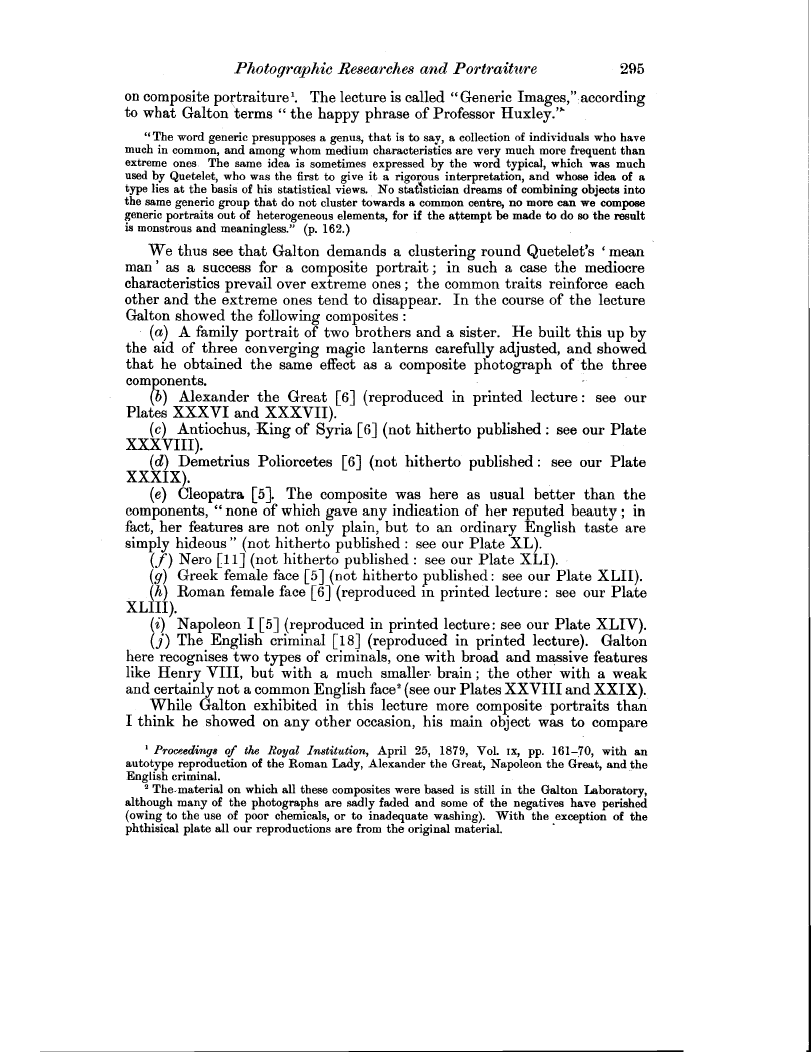Photographic Researches and Portraiture 295
on composite portraiture'. The lecture is called" Generic Images,", according to what Galton terms " the happy phrase of Professor Huxley."
"The word generic presupposes a genus, that is to say, a collection of individuals who have much in common, and among whom medium characteristics are very much more frequent than extreme ones. The same idea is sometimes expressed by the word typical, which was much
used by Quetelet, who was the first to give it a rigorous interpretation, and whose idea of a type lies at the basis of his statistical views. No statistician dreams of combining objects into the same generic group that do not cluster towards a common centre, no more can we compose generic portraits out of heterogeneous elements, for if the attempt be made to do so the result
is monstrous and meaningless." (p. 162.)
We thus see that Galton demands a clustering round Quetelet's `mean man' as a success for a composite portrait ; in such a case the mediocre characteristics prevail over extreme ones ; the common traits reinforce each other and the extreme ones tend to disappear. In the course of the lecture Galton showed the following composites
(a) A family portrait of two brothers and a sister. He built this up by the aid of three converging magic lanterns carefully adjusted, and showed that he obtained the same effect as a composite photograph of the three com onents.
(b) Alexander the Great [6] (reproduced in printed lecture : see our Plates XXXVI and XXXVII).
(c) Antiochus, King of Syria [6] (not hitherto published : see our Plate XXXVIII).
(d) Demetrius Poliorcetes [6] (not hitherto published : see our Plate XXXIX).
(e) Cleopatra [5]. The composite was here as usual better than the components, " none of which gave any indication of her reputed beauty ; in fact, her features are not only plain, but to an ordinary English taste are simply hideous" (not hitherto published : see our Plate XL).
(f) Nero [11] (not hitherto published: see our Plate XLI).
(g) Greek female face [5] (not hitherto published : see our Plate XLII).
(h) Roman female face [6] (reproduced in printed lecture : see our Plate XLIII).
(i) Napoleon I [5] (reproduced in printed lecture: see our Plate XLIV).
(j) The English criminal [18] (reproduced in printed lecture). Galton
here recognises two types of criminals, one with broad and massive features
like Henry VIII, but with a much smaller brain ; the other with a weak
and certainly not a common English faces (see our Plates XXVIII and XXIX).
While Galton exhibited in this lecture more composite portraits than
I think he showed on any other occasion, his main object was to compare
' Proceedings of the Royal Institution, April 25, 1879, Vol. ix, pp. 161-70, with an autotype reproduction of the Roman Lady, Alexander the Great, Napoleon the Great, and the English criminal.
2 The-material on which all these composites were based is still in the Galton Laboratory, although many of the photographs are sadly faded and some of the negatives have perished (owing to the use of poor chemicals, or to inadequate washing). With the exception of the phthisical plate all our reproductions are from the original material.

